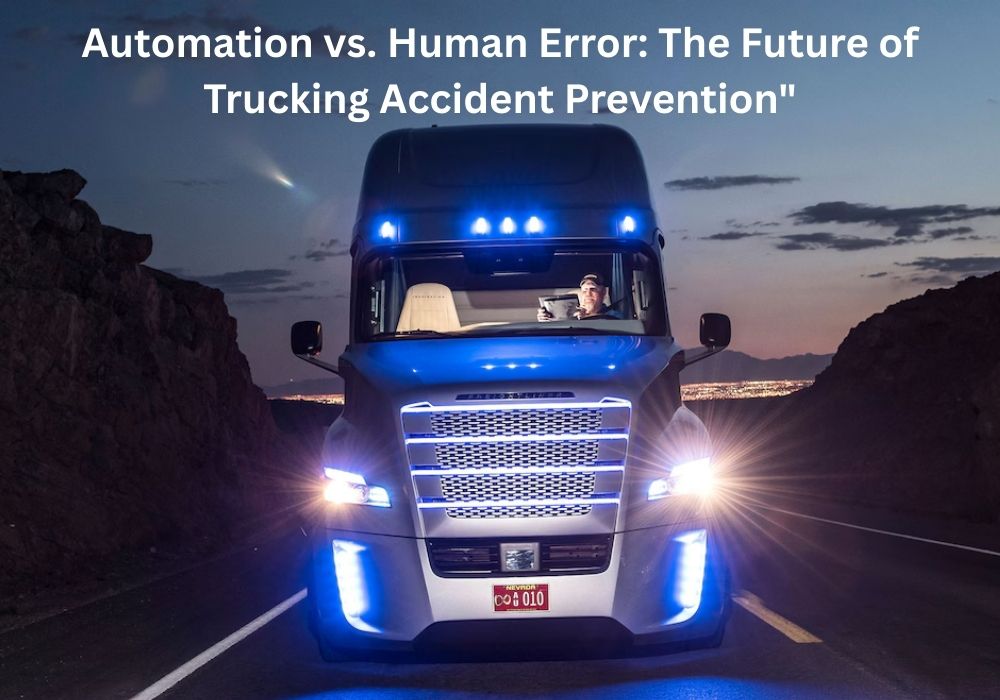More
Automation vs. Human Error: The Future of Trucking Accident Prevention”

On a quiet stretch of interstate, a massive 18-wheeler, laden with goods, veers off the road and crashes into a guardrail, flipping over and spilling its contents onto the highway. Emergency responders arrive quickly at the scene as the investigation gets underway. Was it the driver’s fatigue, a malfunction in the truck’s systems, or perhaps an error in the vehicle’s technology that caused this tragedy?
The cause of truck accidents is often a tangled web of human error, mechanical failure, and even environmental factors. In this case, as investigators dig deeper, they face a pressing question: was this a preventable tragedy, and could automation have made a difference?
In recent years, automation in trucking has gained significant attention as a potential solution to reduce accidents, improve efficiency, and save lives. But as we dive into the complexities of automation, we must ask: can automated systems truly reduce trucking accidents, or do they create new risks of their own?
Understanding the Role of Human Error in Trucking Accidents
Human error remains one of the leading causes of trucking accidents. Driver fatigue, distractions, speeding, and poor decision-making all contribute to the high number of truck-related crashes each year.
The Impact of Fatigue
Long-haul truck drivers often work under tight deadlines, driving for hours without sufficient rest. Fatigue significantly impairs their ability to react to road conditions, leading to slower reaction times and poor judgment. In fact, according to the National Highway Traffic Safety Administration (NHTSA), fatigue was a factor in over 10% of truck accidents in 2020 alone.
Distracted Driving
With the increasing use of mobile devices and in-cab technologies, distracted driving has become a major concern. Drivers may engage with their phones, GPS systems, or other in-cab technologies, which diverts their attention from the road, often resulting in collisions.
The Role of Technology: Can Automation Help?
As automation in trucking continues to evolve, many hope that self-driving trucks equipped with advanced safety technologies could reduce human error and, consequently, trucking accidents. But what do these advancements entail, and how effective are they?
Types of Automation in Trucks
Automation in trucking can be categorized into various levels, from basic driver-assistance systems to fully autonomous trucks. Here’s an overview of the essential technologies involved:
-
Level 1 – Driver Assistance: Includes basic features like lane-keeping assistance and adaptive cruise control, which help the driver maintain control of the vehicle but still require their full attention.
-
Level 2 – Partial Automation: Involves systems like automatic emergency braking and some steering assistance, allowing drivers to engage in tasks like monitoring traffic but still keeping hands on the wheel.
-
Level 3 – Conditional Automation: Trucks can handle most driving tasks, but drivers are still expected to take over in certain situations, such as complex weather conditions or sudden road hazards.
-
Level 4 – High Automation: In certain conditions, the truck can operate fully autonomously without human intervention.
-
Level 5 – Full Automation: The truck is fully autonomous, requiring no driver at all.
Can Automation Reduce Trucking Accidents?
Automation has the potential to significantly reduce accidents caused by human error. Here’s how:
Reduced Fatigue:
Automated systems can take over driving tasks, allowing the truck to operate continuously without the risk of driver fatigue. This could prevent accidents caused by drowsiness or inattention.
Fewer Distractions:
With automation, drivers can focus on monitoring their surroundings rather than handling the vehicle’s steering and acceleration, reducing the likelihood of distractions.
Increased Precision and Consistency:
Autonomous vehicles are designed to make decisions based on data, ensuring precise control of braking, acceleration, and turning. This could minimize human errors such as sudden braking or improper lane changes.
Faster Reaction Times:
Automated systems can process road conditions and hazards far faster than humans, offering quicker reactions to prevent accidents, especially in emergency situations.
Potential Challenges and Limitations of Automation
Despite its promise, automation in trucking isn’t without challenges and concerns. While the technology could reduce many types of accidents, there are still some significant hurdles to overcome:
1. Technology Limitations:
Autonomous vehicles, especially in the trucking industry, still face difficulties in understanding complex road scenarios. Adverse weather conditions, like snow or fog, can confuse sensors, and road conditions may not always be accurately interpreted by the system.
2. Cybersecurity Risks:
As trucks become more connected and autonomous, the risk of hacking increases.
3. Public Trust and Legal Issues:
Even if the technology proves effective, the public and regulators may be hesitant to trust fully autonomous trucks on the road. There may also be legal concerns regarding liability in the event of an accident involving an autonomous vehicle.
4. Driver Displacement:
The introduction of autonomous vehicles raises concerns about the displacement of truck drivers, an issue that could have economic and social implications. While automation could reduce accidents, it also threatens millions of jobs in the trucking industry.
FAQs
Q1: How does automation in trucks reduce the risk of accidents?
Automation reduces human error, including fatigue, distraction, and poor decision-making. By taking over driving tasks, automated trucks can react faster to road conditions, providing better safety and precision.
Q2: What are the risks of automated trucks?
The risks include technology limitations (such as issues with weather conditions), cybersecurity vulnerabilities, and legal challenges regarding liability. There’s also the concern of displacing human drivers in the workforce.
Q3: Are autonomous trucks already on the roads?
Yes, autonomous trucks are currently being tested by several companies, but widespread deployment is still in the experimental phase. Several companies are working toward regulatory approval and technology refinement before full-scale use.
Conclusion
The debate between technology and tragedy in the trucking industry hinges on whether automation can reduce the number of accidents on the road. While automation has the potential to eliminate human errors like fatigue, distractions, and poor judgment, the technology still faces several hurdles, from legal concerns to technological limitations.
The future of trucking may very well lie in a hybrid approach, where automation complements human drivers, allowing the best of both worlds: the precision and safety of machines with the judgment and flexibility of humans. As the technology advances and becomes more reliable, it’s likely that automation will play an increasingly vital role in reducing trucking accidents. However, the ultimate goal should be a safer road environment, no matter how that is achieved.
READ ALSO:
Msafely: The Ultimate Solution for Discreet Phone Monitoring and Safety
More
Candizi: The Sweet Revolution Blending Wellness, Flavor & Experience

Discover Candizi—the innovative candy brand designed to satisfy cravings while promoting healthy living. Combining functional ingredients, vibrant taste experiences, and creative engagement, Candizi is remaking the idea of what sweets can be. Let’s unwrap how this brand stands apart.
1. How Candizi Came to Life with Heart & Health
Candizi began as a passion project among wellness-driven founders who desired a guilt-free snack. What started with small-scale kitchen tests quickly evolved through meticulous recipe development, extensive taste-testing, and consumer feedback.
This journey shaped a clear mission: offer indulgent treats that fuel rather than deplete. By emphasizing quality ingredients and nutritional purpose, Candizi challenges the notion that treats must be unhealthy.
Today, their philosophy is simple yet bold—balance and mindful pleasure. Candizi is proof that you don’t have to choose between joy and wellness.
2. Health-Conscious Ingredients That Stand Out
Rather than relying on refined sugars, Candizi backs its sweetness with natural alternatives. This choice not only lowers caloric impact but adds a clean, subtle flavor profile to every bite
Infused with nutrient-rich ingredients like chia, cacao, and real fruit extracts, each product delivers more than just taste—it offers nourishment. Whether boosting antioxidants or supporting digestion, Candizi treats aim to deliver purpose.
Candizi also champions inclusivity: many of its offerings are vegan, gluten-free, and mild on common allergens. This thoughtful ingredient selection invites a wide range of consumers to enjoy without compromise.
3. Explosion of Flavors & Formats to Suit All Tastes
Candizi offers an impressive variety—everything from tropical gummy blends like mango-pineapple to bold chocolate combinations such as chili-cardamom truffles.
Beyond candies, their lineup includes syrups (perfect for lattes or pancakes), baking enhancers, and seasonal specials. Each release, such as peppermint winter drops or summer berry syrups, keeps fans excited and engaged.
Because products cater to every craving—spicy, fruity, chocolatey, or classic—Candizi provides endless ways to enjoy, ensuring there’s always something new to try.
4. Packaging & Digital Strategy Inspire Connection
Candizi isn’t just a sweet brand; it’s an experience. Picture vibrant, eco-friendly packaging with AR interactivity—scan a code to unlock animations, games, or loyalty rewards. These digital features bridge the physical-digital gap .
Social campaigns, like #CandiziCrave and pop-up tastings, infuse excitement into communities. The brand taps into influencer reviews and unboxings, generating authentic buzz across platforms like TikTok and Instagram.
This layered approach makes customers feel part of a flavorful movement—one that celebrates wellness, creativity, and informed enjoyment.
5. Real Feedback: What People Love About Candizi
Consumers are sharing transformational stories—energy is up, cravings are healthier, and indulgences feel rewarding rather than regretful. User testimonials highlight balance: “I get the candy fix and the wellness boost.”
Social feeds are full of bright, mouthwatering unboxings. Fans gush over innovative flavor mashups like watermelon chili gummies or blueberry lemonade sour belts—flavors that surprise and delight.
This enthusiastic community isn’t just consuming—they’re contributing. Recipes, pairings, and remix ideas pepper forums, reinforcing Candizi’s role as a creative staple.
6. Where to Find & Enjoy Candizi Sweetly
Candizi is available through multiple channels:
-
Specialty retailers & health stores: Featuring limited-run flavors and bulk packs.
-
Online shop & ecommerce platforms: Nationwide shipping, customizable bundles, and subscription options.
-
Events & pop-ups: Seasonal markets and festivals offer exclusive flavors and brand interaction
This multichannel approach ensures accessibility while keeping discovery fun and experiential.
Conclusion:
Candizi is more than candy—it’s a wellness-forward, flavor-forward, experience-first brand. By prioritizing clean ingredients, creative flavors, and tech-enabled engagement, Candizi delivers treats that are as enriching as they are delicious.
FAQs
Q1: Does Candizi deliver real health benefits?
Yes—natural sweeteners and superfood ingredients help reduce sugar spikes and enhance energy with lasting effects
Q2: Are any Candizi products vegan or gluten-free?
Absolutely. Many varieties are vegan, gluten-free, and cater to common allergen concerns .
Q3: What unique flavors does Candizi offer?
Expect creative blends like mango‑pineapple gummies, chili‑cardamom truffles, watermelon chili, and blueberry lemonade
Q4: How does digital interaction enhance my experience?
With AR-enhanced packaging, loyalty rewards, and interactive campaigns, Candizi’s digital tools elevate engagement and community .
Q5: Where can I purchase Candizi?
You can find them in select retailers, through their online store, on major ecommerce sites, and at in-person pop-ups.
READ ALSO:
More
Boost Your Creator Income: How to Optimize Your Bio Link for Maximum Earnings

In the ever-evolving creator economy, your bio link isn’t just a line of text—it’s your digital storefront. Whether you’re a content creator, influencer, artist, or coach, a well-optimized bio link can significantly increase your income by turning casual followers into paying fans, clients, or subscribers.
Let’s break down how you can turn that one small link into a high-converting, income-generating tool.
What Is a Bio Link, and Why It Matters
It is the clickable URL in your social media profile—usually on platforms like Instagram, TikTok, YouTube, or Twitter. Since most platforms allow only one link in your bio, this real estate is precious. Instead of sending users to a single page, creators are using tools like Linktree, Beacons, Koji, and Carrd to build mini landing pages that direct traffic to multiple destinations.
If you’re only linking to a single website or product, you’re missing out on valuable income opportunities.
Why Optimizing Your Bio Link Is Key to Higher Income
A bio link acts as a conversion funnel. It helps guide your audience toward desired actions—subscribing to your newsletter, booking a service, watching a video, or buying a product. Done right, it becomes your silent salesperson, working 24/7.
How to Maximize Creator Income with a Smart Bio Link Strategy
1. Use a Multi-Link Tool with Analytics
Tools like Linktree, Beacons, or Stan Store let you add multiple links and track performance. This helps you see what’s converting best—and tweak accordingly.
2. Prioritize High-Value CTAs
Arrange your 🔗 strategically. Put your most profitable or urgent calls-to-action (CTAs) at the top. Whether it’s a product launch, a new video, or a Patreon sign-up, make it the first thing people see.
3. Design for Mobile First
Over 90% of profile🔗 clicks come from mobile devices. Choose a clean, mobile-friendly layout. Use bold fonts, short descriptions, and easy-to-tap buttons.
4. Add Social Proof
Include testimonials, follower counts, or “as seen in” media mentions on your bio page. These add credibility and boost conversion rates.
5. Showcase Digital Products or Services
Whether you sell eBooks, courses, presets, or consultations, your bio 🔗 should clearly promote your top offerings with images, short descriptions, and direct purchase links.
6. Keep It Fresh
Update your 🔗 regularly to align with your current content or campaigns. An outdated link can confuse your audience or lead to missed opportunities.
7. Integrate Email Capture
Use your bio page to offer a freebie in exchange for email addresses. Building your own email list gives you long-term control over your audience—and more monetization power.
Monetization Opportunities You Can Highlight in Your Bio Link
-
YouTube or TikTok channel
-
Online store or merch
-
Coaching sessions or consultations
-
Newsletter signup
-
Patreon or membership site
-
Event registration
-
Podcast episodes
FAQs:
Q1: What’s the best bio link tool for creators?
Popular tools include Linktree, Beacons, Stan Store, and Koji. The best one depends on your goals—some are better for selling products, others for affiliate marketing or services.
Q2: How often should I update my link in bio?
Ideally, every 1–2 weeks or whenever you launch something new. Keeping it current maintains relevance and engagement.
Q3: Can a bio link help with affiliate marketing?
Absolutely. You can include affiliate product links with tracking codes and even group them by category for better click-through rates.
Q4: Should I create a custom URL for my bio link?
Yes. A branded, short domain (e.g., yourname.bio or yourbrand.link) looks more professional and is easier to remember.
Q5: Do analytics really matter?
Yes! Tracking clicks, views, and conversions helps you understand what your audience wants—and how to serve it better.
READ ALSO:
InfluencersGoneWild: The Bold Trendsetters Redefining Social Media Culture
More
Stylish Cat Furniture That Elevates Your Space and Delights Your Pet

Gone are the days of unsightly cat trees and dull scratching posts. Today, cat stylish furniture is revolutionizing the way pet parents integrate their feline friends into modern home design. Whether you’re a minimalist, a boho-lover, or a fan of Scandinavian décor — there’s a chic cat furniture piece waiting to upgrade your space and spoil your kitty.
Why Stylish Cat Furniture Is Trending
Let’s face it — cats are royalty. But traditional pet furniture? Not so much. Cat owners are now looking for products that:
-
Blend seamlessly with home decor
-
Prioritize comfort and functionality
-
Support sustainability and quality craftsmanship
What to Look for in Cat Stylish Furniture
Before adding that Instagram-worthy cat condo to your cart, here are some features you and your cat will love:
1. Aesthetic Appeal
Neutral colors, clean lines, and natural materials (like wood or rattan) work well in modern interiors.
2. Multi-Functional Design
Think side tables with built-in beds, TV stands with hiding spots, or floating shelves that double as climbing zones.
3. Durability & Stability
Scratch-resistant fabrics, anti-tip design, and heavy bases are must-haves for active felines.
4. Cat Comfort
Soft cushioning, cozy cubbies, and lounging space make it a cat’s dream spot.
Best Cat Stylish Furniture Picks in 2025
Here are top-rated products making waves with both design lovers and picky cats:
1. Tuft + Paw Frond Cat Tree
-
Scandinavian-inspired design
-
Multiple levels for climbing and napping
-
Eco-friendly materials
2. MAU Modern Wooden Wall Shelves
-
Floating shelf set for vertical play
-
Sleek walnut finish that matches furniture
-
Loved by apartment dwellers
3. Vesper V-High Base Modern Cat Tower
-
Space-saving design with soft memory foam cushions
-
Dark wood laminate finish
-
Excellent for active cats and small spaces
4. The Refined Feline Lotus Leaf Cat Shelf
-
Sculptural, elegant design
-
Doubles as wall art
-
Designed to hold even large cats comfortably
Smart Design Ideas for Cat Furniture Integration
-
Neutral color schemes: Beige, gray, or wood tones match almost any room.
-
Corner placement: Stylish corner condos make use of under-utilized space.
-
Wall-mounted furniture: Keeps your floor clear and adds architectural interest.
How Much Should You Spend on Stylish Cat Furniture?
Prices vary based on brand, material, and complexity:
-
Basic stylish pieces: $50–$150
-
Luxury designer cat furniture: $200–$600+
-
DIY projects: Budget-friendly and customizable!
Remember: stylish doesn’t always mean expensive. Look for deals, reviews, and brand reputation.
Cleaning and Maintenance Tips
-
Vacuum or lint-roll fabric often
-
Use pet-safe cleaning sprays for wood surfaces
-
Trim your cat’s claws to extend the life of scratchable materials
FAQs
Q1: Is stylish cat furniture really functional for cats?
Yes! Modern designs now prioritize both aesthetics and feline comfort. Always check reviews for real-world usability.
Q2: Where can I buy cat stylish furniture?
Popular places include Tuft + Paw, Amazon, Etsy, Chewy, and even IKEA hacks for cat-friendly home setups.
Q3: Do cats prefer enclosed or open furniture?
It depends on your cat’s personality. Shy cats love enclosed spaces, while confident ones enjoy perches and open beds.
Q4: Can I build my own stylish cat furniture?
Absolutely! Many cat parents DIY pieces using plywood, sisal rope, and upholstery fabric — all budget-friendly and customizable.
Final Meow:
Stylish cat furniture isn’t just a trend — it’s a lifestyle upgrade for both you and your feline friend. With the right pieces, you can create a pet-friendly home that doesn’t compromise on design. Because in your house, the cat is the vibe.
READ ALSO:
-

 More7 months ago
More7 months agoThe Rise of Lillienu: Transforming Technology and Creativity
-

 Fashion7 months ago
Fashion7 months agoUnveiling the Secrets of Ceylan Eye Cream Reviews
-

 More7 months ago
More7 months agoThe Rise of Artofzio: Transforming Creativity in the Digital Era
-

 More7 months ago
More7 months agoSwindle Trilogy Website: A Must-Visit Hub for Book Lovers
-

 More7 months ago
More7 months agoInfluencersginewuld: Revolutionizing the Influencer Marketing Landscape
-

 More7 months ago
More7 months agoCeylan Eye Cream Reviews: Is It Worth the Hype?
-

 Business7 months ago
Business7 months agoIvermectin: The Medication That Changed Global Health
-

 News6 months ago
News6 months agoThe Shocking Details of the Scott Levin 2011 Truck Accident
